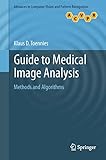Guide to Medical Image Analysis : Methods and Algorithms / by Klaus D. Toennies.
Tipo de material: TextoSeries Advances in Computer Vision and Pattern RecognitionEditor: London : Springer London : Imprint: Springer, 2012Descripción: xx, 468 páginas 327 ilustraciones recurso en líneaTipo de contenido:
TextoSeries Advances in Computer Vision and Pattern RecognitionEditor: London : Springer London : Imprint: Springer, 2012Descripción: xx, 468 páginas 327 ilustraciones recurso en líneaTipo de contenido: - texto
- computadora
- recurso en línea
- 9781447127512
- TA1637-1638
Springer eBooks
The Analysis of Medical Images -- Digital Image Acquisition -- Image Storage and Transfer -- Image Enhancement -- Feature Detection -- Segmentation: Principles and Basic Techniques -- Segmentation in Feature Space -- Segmentation as a Graph Problem -- Active Contours and Active Surfaces -- Registration and Normalization -- Detection and Segmentation by Shape and Appearance -- Classification and Clustering -- Validation -- Optimisation of Markov Random Fields -- Variational Calculus -- Principal Component Analysis -- References.
Analysis of medical imaging poses special challenges distinct from traditional image analysis. Furthermore, the analysis must fit into the clinical workflow within which it has been requested. This important guide/reference presents a comprehensive overview of medical image analysis. Highly practical in its approach, the text is uniquely structured by potential applications, supported by exercises throughout. Each of the key concepts are introduced in a concise manner, allowing the reader to understand the interdependencies between them before exploring the deeper details and derivations. Topics and features: Presents learning objectives, exercises and concluding remarks in each chapter, in addition to a glossary of abbreviations Describes a range of common imaging techniques, reconstruction techniques and image artefacts Discusses the archival and transfer of images, including the HL7 and DICOM standards Presents a selection of techniques for the enhancement of contrast and edges, for noise reduction and for edge-preserving smoothing Examines various feature detection and segmentation techniques, together with methods for computing a registration or normalisation transformation Explores object detection, as well as classification based on segment attributes such as shape and appearance Reviews the validation of an analysis method Includes appendices on Markov random field optimization, variational calculus and principal component analysis This easy-to-follow, classroom-tested textbook is ideal for undergraduate and graduate courses on medical image analysis and related subjects – with possible course outlines suggested in the Preface. The work can also be used as a self-study guide for professionals in medical imaging technology, and for computer scientists and engineers wishing to specialise in medical applications.
Para consulta fuera de la UANL se requiere clave de acceso remoto.


